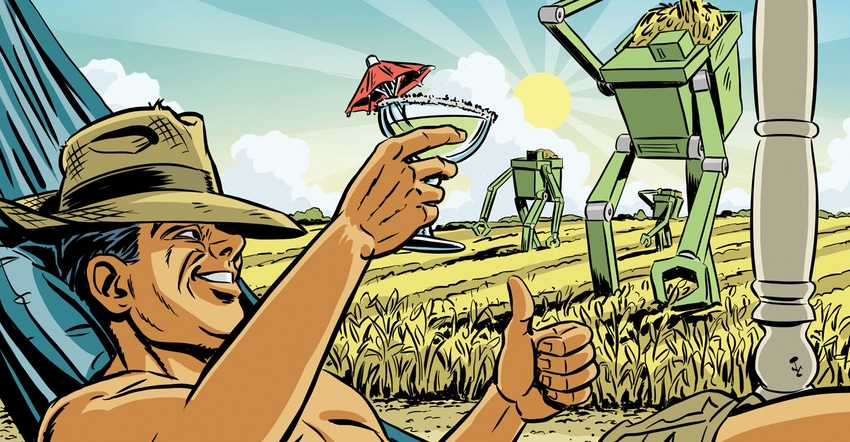
While the world grapples with trade wars and climate change, take heart: Malthus, the infamous economist who predicted dire world famine in 1798, was dead wrong. And he remains wrong more than 300 years later — mainly because he never dreamed how technology would help solve global food problems.
Malthus couldn’t imagine perfect farms with 500-bushel corn yields, where fertilizer never runs off, where crops get just the right amount of light and moisture. He couldn’t envision a world where food is fortified, healthier, more nutritious, tastier, traceable and joyfully eaten by consumers satisfied in knowing who and how it was made.
Technology moves us toward that day, but it won’t come without some hiccups. When genetically modified technology came along, agriculture rejoiced — and the rest of the world freaked out. GMOs have been great for saving soil and farmer health, but they get a poor reception among consumers who could see no such benefits. The lesson: Embrace the right technology or reap the consequences.
In our four-part series we share what’s coming to you, or your kids’ farm operations, in the not too distant future. And we start with:
Cheaper, better data will boost yields
Genetics drive yield in staple crops, but we’re only skimming the surface on potential. Biologicals could boost yields even higher. So could cheaper digital technologies. Precision data — in this case, soil or crop sensors along with equipment — could improve transparency, traceability and profitability all at once.
Each growing season, farmers make about 40 yield-impacting management decisions. Planting and harvest timing alone can result in a 10% yield swing. Those decisions, combined with random acts of nature, equal that year’s yield.
According to Todd Mockler, principal investigator at Danforth Plant Science Center and co-founder of Benson Hill Biosystems, 80% of the needed increases in productivity could be achieved from improved management techniques that close the gap between theoretical (potential) yield and current yield.
So far, the storyline with data is tangled with frustrations. Farmers already wrestle with too much data — and don’t always know what to do with the data they have. Or they aren’t seeing profitable results from the data-driven decisions they make.
But what if technology made those decisions? What if sensors and equipment made perfect decisions based on your growing season goals? What if a sensor sent a message to an autonomous machine, which then made a decision, took an action (a drone application, or a self-driven sprayer, for example) and then learned from that “experience” for future optimization?
It’s happening now.
“What’s needed to make precision ag and a future smart farm a reality is cheaper data,” Mockler says. “We need advanced in-field micro-sensors at low cost for row crops, not just high-value crops like almonds or vegetables in glass houses. Low-cost micro-sensor systems will enable broad-acre-scale adoption of smart-farm technologies. That’s when we’ll see yields start to shoot higher.”
The precision ag field is competitive; the analytics are good; and it’s mostly user-friendly for growers or decision-makers. “The problem with precision is cost,” he says. “It doesn’t make sense to deploy extremely expensive sensors on low-margin crops over large areas. But over time, costs will be driven down, making that very promising for row crop ag.”
The cost of sensor technology has already faded enough in recent years that the livestock industry is moving from research and development to on-farm applications, says Corrie Brown, pathology professor at the University of Georgia.
The most promising research centers on using sensors for early detection of diseases or other aspects of livestock health. Using the same basic principles as glucose sensors for diabetes in humans, some livestock sensors can detect changes in cortisol levels in animal hair and skin to measure stresses that could signal a disease outbreak.
And sound algorithm sensors are being used to catch bovine respiratory syndrome before it affects the entire herd. Others can observe lactate levels in cow saliva to better monitor milk productivity.
“Sensors have to be more affordable, but I do see things headed in the right direction,” Brown says.
That’s especially true for sensors that monitor crops. So far, the ROI is harder to match compared to livestock sensors, but the potential benefits could be enormous for plant health and water usage.
“Imagine what sensors could do to save water in areas like the Ogallala Aquifer, where we’re removing water faster than it’s being replenished,” Brown says. “For that reason alone, it certainly would be nice to have more sensors monitoring crops.”
Coming in part two: Robots will solve labor problems, and a whole lot more
Coming in part three: Retail disruption will change how we grow what we eat
Coming in part four: A new gene-editing toolbox will revolutionize farming and food production.
About the Author(s)
You May Also Like








